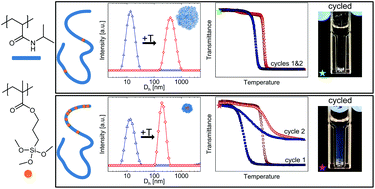Role of chain architecture in the solution phase assembly and thermoreversibility of aqueous PNIPAM/silyl methacrylate copolymers†
Abstract
Stimuli-responsive polymers functionalized with reactive inorganic groups enable creation of macromolecular structures such as hydrogels, micelles, and coatings that demonstrate smart behavior. Prior studies using poly(N-isopropyl acrylamide-co-3-(trimethoxysilyl)propyl methacrylate) (P(NIPAM-co-TMA)) have stabilized micelles and produced functional nanoscale coatings; however, such systems show limited responsiveness over multiple thermal cycles. Here, polymer architecture and TMA content are connected to the aqueous self-assembly, optical response, and thermoreversibility of two distinct types of PNIPAM/TMA copolymers: random P(NIPAM-co-TMA), and a ‘blocky-functionalized’ copolymer where TMA is localized to one portion of the chain, P(NIPAM-b-NIPAM-co-TMA). Aqueous solution behavior characterized via cloud point testing (CPT), dynamic light scattering (DLS), and variable-temperature nuclear magnetic resonance spectroscopy (NMR) demonstrates that thermoresponsiveness and thermoreversibility over multiple cycles is a strong function of polymer configuration and TMA content. Despite low TMA content (≤2 mol%), blocky-functionalized copolymers assemble into small, well-ordered structures above the cloud point that lead to distinct transmittance behaviors and stimuli-responsiveness over multiple cycles. Conversely, random copolymers form disordered aggregates at elevated temperatures, and only exhibit thermoreversibility at negligible TMA fractions (0.5 mol%); higher TMA content leads to irreversible structure formation. This understanding of the architectural and assembly effects on the thermal cyclability of aqueous PNIPAM-co-TMA can be used to improve the scalability of responsive polymer applications requiring thermoreversible behavior, including sensing, separations, and functional coatings.



 Please wait while we load your content...
Please wait while we load your content...
